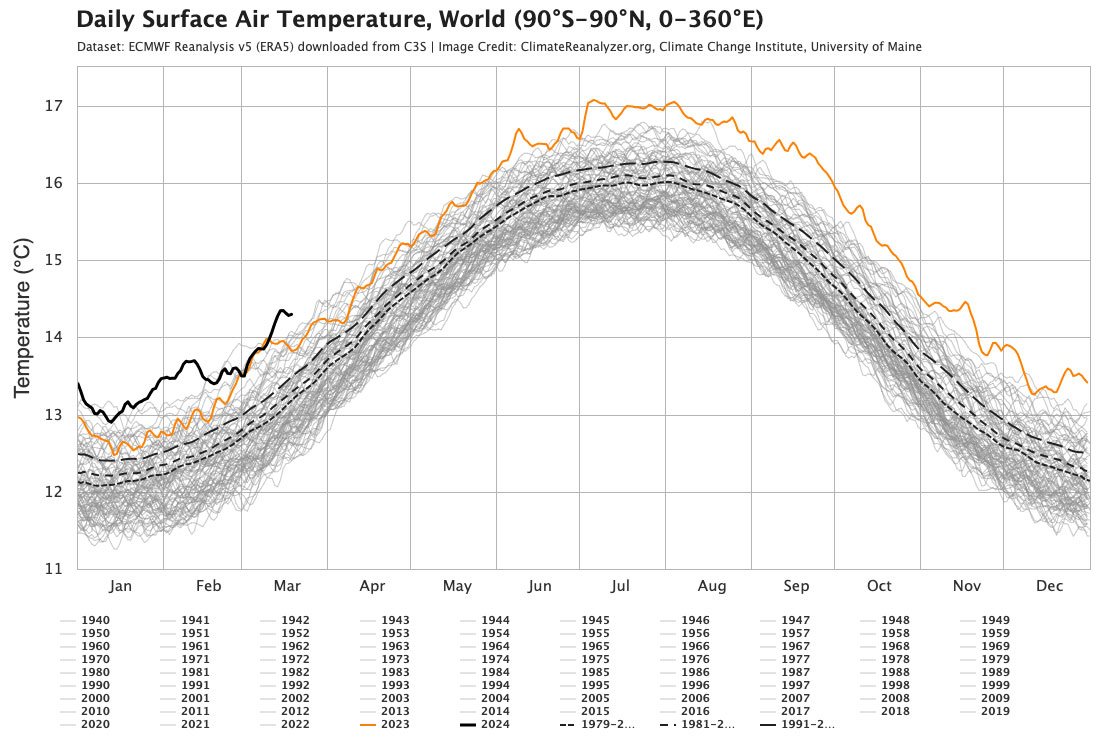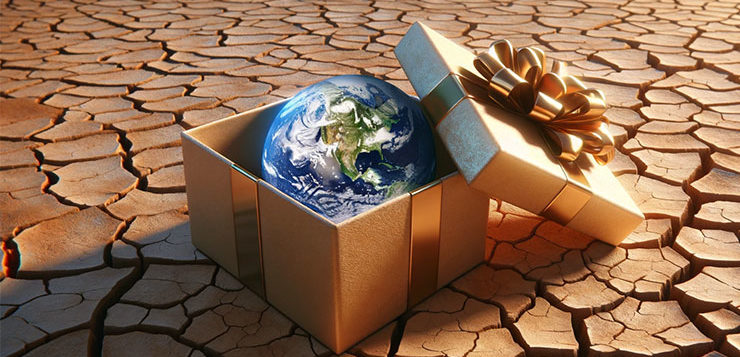It’s Earth Day on April 22, and while that’s technically not a birthday celebration, a great present for humanity would be an effective solution to the growing climate crisis. You could do worse than putting a price on carbon and compensating families for the additional cost, writes Aarzu Patni.
As Earth Day (April 22) approaches, we find ourselves at a crossroads, with the path we choose likely to determine whether or not human beings can preserve a liveable world for everyone.
The need to accelerate the pace of decarbonization has grown more urgent as planetary warming shows no signs of abating. Last July, the Earth experienced four days in a row of record-shattering temperatures. The EU’s Copernicus Climate Change Service reported in February that during the previous 12 months, global temperatures were 1.5 degrees Celsius warmer than the pre-industrial era, breaching, at least for a year, a dangerous threshold for warming.

Increased temperatures are melting Greenland’s ice so fast that the melt off threatens to shut down the Atlantic Meridional Overturning Circulation which contains the Gulf Stream that keeps much of Europe from freezing over.
Not even getting started on the 2019 bushfires, this summer Australia has seen its share of extreme weather, facing heatwaves, thunderstorms and a cyclone. Recently, the community of Borroloola, off the Gulf of Carpentaria coast, saw record-breaking floods, and hundreds of residents have been evacuated as a “once-in-a-hundred-year flood” is predicted to be imminent.
More and more of us are feeling the climate emergency on a personal level. As a 17-year-old Indian Australian, it isn’t just my future at stake, but the present of my family back in India. From April to May, India enters its pre-monsoon season, its hottest period of the year, and it’s all I can do to pray for my grandparents, aunts, uncles, cousins.
Last year saw record breaking temperatures approaching 50 degrees celsius, which had people being fried alive, dying of heatstroke as they walked, suffocating on their way down to the shops, fainting on the streets. Every call with my family, I’d hear how they’d been unable to leave the house for months, but I’d still be thanking God they were okay. And I’m now bracing myself for another two months of that.

So, what is the path to avoid the collapse of environmental systems? Every major study agrees we must stop burning fossil fuels — the source of most heat-trapping gases — as quickly as possible. Currently, the speed with which we’re phasing out the use of oil, gas and coal is not fast enough to contain warming to 1.5 degrees celsius.
“As things stand, demand for fossil fuels is set to remain far too high to keep within reach the Paris Agreement goal of limiting the rise in average global temperatures to 1.5°C,” the International Energy Agency said in a report last fall.
A UN report released just before COP28 in Dubai predicts that current emissions pledges put the world on track to warm nearly 3 degrees celsius by the end of the century. “Present trends are racing our planet down a dead-end 3C temperature rise,” said UN Secretary-General Antonio Guterres. “The emissions gap is more like an emissions canyon.”
There is, however, a tool that can accelerate the phaseout of fossil fuels, one that nearly all economists agree on: a price on carbon. The catch, though, is that to discourage the demand for these fuels, the price, tax or fee on the carbon pollution these fuels emit needs to be very high. Such a high price will increase costs, creating an economic burden for households everywhere and causing a backlash against governments that impose a carbon price.
But what if we can lift that economic burden off the shoulders of people and put it squarely on polluters where it belongs? The solution is simple. Take the revenue collected from the carbon fee and give it to households, a policy known as climate income. A working paper from Citizens’ Climate Education on the financial impact of one such policy found that two-thirds of households would receive more than enough money to offset their increased costs. Because they have a relatively small carbon footprint, people in low- and middle-income households are likely to receive more than they need to offset costs.
In Canada, where carbon tax revenue is returned to households through the Carbon Rebate program, the price on carbon is now $80 per ton of carbon dioxide. To ensure that the carbon tax will achieve the desired emissions reductions, the price will rise to $170 per ton by 2030. This would not be possible politically without the Carbon Rebate, whereby 80% of households get as much or more than the increased cost associated with the carbon price.
Currently, Australia does not levy an explicit carbon price. In 2021, however, as part of the Ryde Youth Council in the Bennelong electorate, I successfully lobbied the City of Ryde Council to endorse the proposed climate income model, bringing us closer to achieving this goal.
In order to maintain a level playing field for businesses in countries that price carbon, a fee can be assessed to imports at the border, a policy known as a carbon border adjustment mechanism (CBAM). The European Union is currently rolling out a CBAM that will take effect in 2026. Such a tariff will provide a strong incentive for the EU’s trading partners to implement a carbon price of their own to avoid paying a border fee.
As we pause this Earth Day to appreciate our life-sustaining planet, let’s resolve to take meaningful action to preserve a liveable world by speeding up the transition away from fossil fuels.
Climate income — a carbon price with revenue given to households — is an effective tool for achieving that goal.
– Additional research, Joe Robertson, Executive Director of Citizens’ Climate International.
Donate To New Matilda
New Matilda is a small, independent media outlet. We survive through reader contributions, and never losing a lawsuit. If you got something from this article, giving something back helps us to continue speaking truth to power. Every little bit counts.




